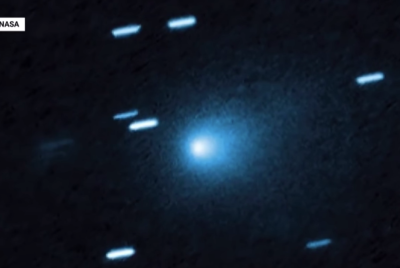3I/ATLAS Survived Perihelion as Single Body — Harvard's Loeb Questions Its Origin
The mystery surrounding this unbroken visitor deepens

An interstellar visitor, Comet 3I/ATLAS, has stunned scientists by holding together as it skimmed the Sun. This resilience defies typical expectations for such celestial travellers.
Now, a leading voice in astrophysics, Avi Loeb of Harvard, is reigniting debate by questioning what brought this remarkable object to our solar system in the first place, suggesting its origins may be far stranger than previously assumed.
The Intact Interstellar Visitor
Fresh images of 3I/ATLAS, captured on 11 November 2025, from the Nordic Optical Telescope at La Palma in the Canary Islands, show the interstellar interloper has not broken up since it passed closest to the Sun (perihelion) on 29 October. Writing on his blog, Professor Avi Loeb notes:
'The prominent elongation in the glow surrounding 3I/ATLAS projects to a position angle of 106 (+/-10) degrees. This is close to the projected sunward direction of 115 degrees. It resembles the image obtained by the Hubble Space Telescope on 21 July 2025, which showed an anti-tail pointing towards the Sun.'
🚨 Something Strange About 3I/ATLAS... 🚨
— Astronomy Vibes (@AstronomyVibes) November 13, 2025
New images from the Nordic Optical Telescope (taken on Nov 11, 2025 by astronomers David Jewitt and Jane Luu) just dropped — and 3I/ATLAS looks nothing like a normal comet.
It’s still active, still glowing… and shooting a massive jet… pic.twitter.com/uiU7VsZhw9
'The new image also shows a weaker asymmetry at a position angle of 301 (+/-1) degrees, which is close to the projected anti-solar direction of 295 degrees.' He further notes, 'Given the large-scale jets reported recently, the fact that 3I/ATLAS remains a single body is surprising for a natural comet.'
Measuring the Outflow
Professor Loeb also states that observations of the interstellar object 3I/ATLAS on 9 November 2029 revealed plumes stretching about one million kilometres towards the Sun and three million kilometres in the opposite direction.
He calculates that, based on the anticipated outflow speed for a natural comet, which is 0.4 km/s, these eruptions must have carried on for one to three months.
He then states that the examination suggests the jets' mass density at one million kilometres is several million proton masses per cubic centimetre, indicating a mass flow of five billion tonnes each month.
🚨 BREAKING: “If it’s technological… yes, we’re screwed.” — Avi Loeb on FOX 10
— Ezee (@EzeemmaCraic) November 7, 2025
The Harvard astrophysicist just confirmed what many feared.
Congresswoman Anna Paulina Luna reportedly met with NASA today — demanding the release of the HiRISE Mars Orbiter images of 3I/ATLAS, the… pic.twitter.com/AvgzQYTpps
Vaporising this amount of CO₂ ice requires 3 × 10^18 Joules of energy. Considering the Sun's energy flow at perihelion, this requires an absorbing surface larger than 1,600 square kilometres—the same as a sphere measuring 23 kilometres across.
He states that this is four times bigger than the maximum diameter of 5.6 kilometres for 3I/ATLAS observed by the Hubble Space Telescope. If the material were water ice, the necessary diameter would jump to 51 kilometres.'
Because natural comets usually have ice patches covering only a small part of their surface, these figures do not match the idea of 3I/ATLAS being a single, solid object.
An Enigma Beyond Expectations
The enduring survival of 3I/ATLAS through perihelion confirms its extraordinary nature, yet the required energy calculations present a profound cosmic puzzle. If the object truly remained intact, its enormous outflow suggests a vast, absorbing surface that far exceeds its observable dimensions.
This fundamental disparity compels us to reassess the composition and structure of the interstellar visitor. For Professor Loeb, this inconsistency strongly suggests the possibility that 3I/ATLAS is not a 'natural comet' in the conventional sense.
Whether it is an unusual fragment, a dense composition never before encountered, or something entirely artificial, the debate over this resilient object's identity and origins has only just begun.
© Copyright IBTimes 2025. All rights reserved.






















